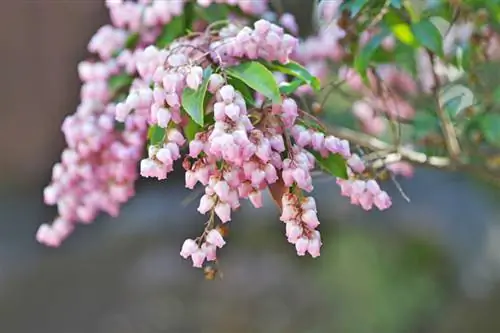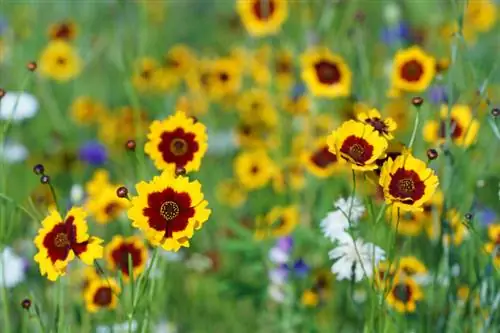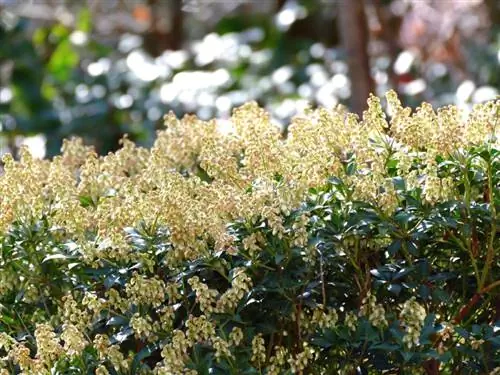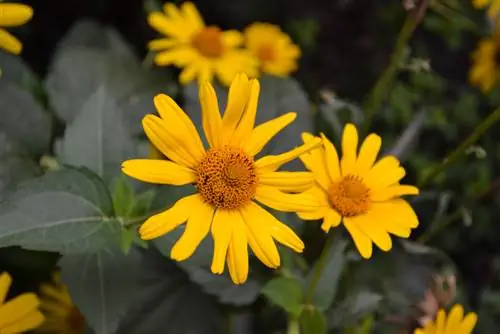- Author admin [email protected].
- Public 2023-12-25 17:45.
- Last modified 2025-01-23 11:22.
If bees and butterflies could design the planting plan, the shadow bell was at the top of the wish list. The spring-fresh ornamental tree provides plenty of food for busy insects. At the same time, lavender heather acts as a feast for the eyes with white and red flowers over evergreen foliage. Read here how cultivation works.
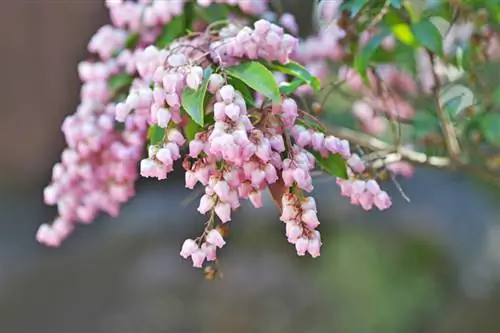
How do you care for a lavender heather (shadow bell)?
The lavender heather (shadow bell) is a hardy ornamental tree that blooms from April to June and is suitable for partially shaded locations. It requires humus-rich, fresh, moist and slightly acidic soil. Regular watering and fertilizing with organic fertilizer promotes he althy growth.
Planting lavender heather correctly
If you plant the shadow bell in autumn, you will create the best conditions for magnificent flowering in the first year. Create a spacious planting pit in a partially shaded location in slightly acidic soil, while the still potted lavender heather is soaked in a bucket with lime-free water. Position the potted young plant in the middle of the pit and fill it with rhododendron soil. After the substrate has been pressed down with your hands, pour generously.
Care tips
The care protocol for shadow bells does not pose any horticultural stumbling blocks. See for yourself with the following overview:
- Water lavender heather regularly with rainwater or decalcified tap water
- Fertilize organically with compost, horn shavings or guano from March to July
- Clean up wilted flowers for a well-groomed appearance
- Carry out shape and maintenance pruning immediately after flowering
Regardless of the stable winter hardiness, we recommend protection in the form of a mulch, secured with pine fronds. The branches with the buds already formed are given a breathable cover made of jute or fleece. Ideally, a bright, frost-free winter quarter is available for shadow bells in the pot.
Which location is suitable?
If the lavender heather finds a partially shaded location, it pulls out all the stops of its floral performance. These lighting conditions promote the splendor of flowers and the beauty of the evergreen foliage in equal measure. However, compromises must be accepted under full sun or in deep shade.read more
The correct planting distance
Since the growth width of the shadow bell either corresponds to the height or even exceeds it, this value is the starting point for the ideal planting distance. We have put together recommended distances for you for common species and varieties:
- Growth height and width 30-50 cm: Planting distance as a solitary plant 40 cm, as a hedge plant 15-25 cm
- Growth height and width 60-80 cm: Planting distance as solitary plants 70 cm, as hedge plants 30-40 cm
- Growth height and width 80-100 cm: Planting distance as a solitary plant 90 cm, as a hedge plant 40-50 cm
What soil does the plant need?
If you plant a shadow bell in this soil, you have the best prospects of vigorous growth and lush flowering year after year:
- Humos and fresh-moist
- Slightly acidic with a pH of 4.2 to 5.5
- Like lean and well drained
The shadow bell feels in the best possible hands in the heath garden or in the middle of the moor bed.
When is flowering time?
Look forward to a long flowering period from April to June. In years with mild winter weather, the first flower spikes sprout from mid to late March. If withered flowers are cleaned out, the shadow bell immediately produces new buds and flowers.
Cut lavender heather correctly
To ensure that the shadow bell impresses with a clean, neat appearance, withered flowers are cut off regularly. If you cut the stems down to the first pair of he althy leaves, there is the best chance of flowering again at this point. Make the central shape and maintenance cut like this:
- Prune shadow bells immediately after flowering
- Short shoots that are too long except for an outward-facing eye (slight thickening under the bark)
- Cut dead wood and stunted branches at the base
If you postpone the pruning date until autumn or spring, you will deprive the ornamental tree of its next flowers, as the buds have already formed at this point.read more
Watering lavender heather
Water shade bells regularly and abundantly, as drought stress affects the beauty of flowers and leaves in both summer and winter. Collected rainwater or decalcified tap water meet the requirements for a slightly acidic substrate particularly well.
Fertilize lavender heather properly
The shadow bell is modest when it comes to nutrient supply. However, you should not completely avoid fertilizer. The addition of acidic leaf or needle compost with nettle manure between March and July is beneficial for the abundance of flowers and leaves. Stop fertilizing at the beginning of August at the latest so that the tree can mature before the first frost.
Diseases
He alth problems are the exception with a properly cared for shadow bell. If symptoms of illness occur, it is usually a fungal infection. First and foremost is the wilting fungus Phytophthora, which causes young lavender heather to die and significantly impairs the growth of adult trees. The disease is triggered by too frequent watering, which leads to waterlogging in the root area. If the leaves turn yellow, the plant can no longer be saved. To prevent this from happening in the first place, water carefully with lime-free water only when the surface of the soil has dried out.read more
Wintering
It's not so much frosty temperatures as intense winter sun and drought stress that can cause problems for a shadow bell. In addition, delayed ground frosts threaten the buds that have already formed in early spring. We therefore recommend the following precautions:
- Pile up the tree slice in the bed with leaves and needles
- Place the bucket on wood, cover it with bubble wrap and cover the substrate with peat moss
- Wrap the branches with jute ribbons or put on a breathable hood made of garden fleece
As a precaution, put pots with a diameter of less than 30 cm in a bright, frost-free winter quarters.
Propagate lavender heather
Anyone who was able to experience the red leaf shoots and the enchanting spring blossoms will want more shade bells for their beds and balconies. It's a good thing that propagation is so uncomplicated. There are the following two methods that make life easy for hobby gardeners:
- Cut cuttings during the flowering period, place them in poor soil and let them root in a partially shaded place
- In May/June, pull half-woody shoots to the ground, score in the middle, cover with substrate and allow to root
read more
Is lavender heather poisonous?
The shade bell is not suitable for the family garden. The high toxic content poses life-threatening dangers for humans and animals. Mere skin contact causes severe irritation. Consuming small amounts causes symptoms of poisoning and even cardiac arrest.read more
Is lavender heather hardy?
The shadow bell has a robust winter hardiness and can withstand temperatures down to -23 degrees Celsius. Special precautions for winter protection are therefore not necessary. This requirement applies to a semi-shady to shady location. If the ornamental tree is in a sunny location, there is a risk of life-threatening drought stress under intense sunlight combined with frost. A thick layer of mulch made of leaf mold and coniferous twigs as well as watering on mild winter days prevent this dilemma.read more
Beautiful varieties
- Valley Valentine: Variety star thanks to red bell flowers and majestic stature; Growth height 80-150 cm
- Forest Flame: Compact growth, bright red shoots of evergreen leaves and white flowers; Growth height 100 cm
- Little Heath: Premium variety with white-pink variegated evergreen leaves and white flowers; Growth height 50-60 cm
- Purity: Spherical habit, strewn with silvery, shiny flower spikes above rich green leaves; Growth height 70-80 cm
- Cavatine: Magnificent specimen for the pot and as grave planting thanks to its compact silhouette; Growth height 40 cm

